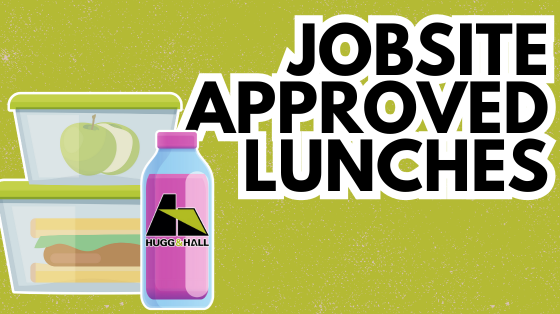
Jobsite Approved Lunches
 Jobsites can be unpredictable, especially while the heat of summer is in full effect!
Jobsites can be unpredictable, especially while the heat of summer is in full effect!
As thousands of Americans carry sack lunches onto the jobsite, it’s important to assure proper cooking and handling has been done. Follow these quick tips to enjoy a safe jobsite lunch.

Although it may be tempting to carry your lunch in an affordable brown bag, or to keep it in a plastic grocery sack, it can be very dangerous. You’ll need an insulated container with at least 2 freezer packs (one above and one below the perishable foods).
An insulated lunchbox and freezer packs keep cold food cold and reduce the spread of harmful bacteria. Bacteria multiply rapidly in foods within the “danger zone” (40°F to 140°F), for more than 2 hours below 90°F, or 1 hour when temperatures surpass 90°F.
Safe lunches begin with safe food preparation.
- Cook food to safe temperatures.
- Use clean utensils and wash all working surfaces.
- When storing leftover meals, immediately place in packaging or airtight containers. Be sure to portion large quantities into smaller dishes to get food in the “safe zone” (at or below 40°F) quickly, to reduce the risk of bacteria.
- Wash your hands thoroughly with soap and water.
- Wash all storage dishes, work surfaces and even your insulated lunch container. If you must use a classic brown paper bag, be sure they are purchased from the food preparation aisle at your local supermarket.
- Don’t over prepare. Packing too much perishable food can cause cooling issues with your cool packs. Too much food is also difficult to dispose of on the jobsite. If you do pack too much, share with a friend to limit food waste.
- When handling liquids or fluid foods, use a thermos to keep foods cold or hot. Hot foods should be packaged in a preheated thermal container. Preheating can be done by placing boiling water into the container and letting it sit for a few minutes before filling with your preheated food.
All perishable foods that are intended to be served cold must be kept cold. Foods prepared with meat (including fish and poultry), eggs, dairy, cut & peeled fruits and vegetables, pasta and rice dishes meet these guidelines.
- Prepared foods made in advance and packaged the evening before should stay refrigerated until they are ready to be added to your lunch container. When morning arrives, you can add foods that do not require refrigeration.
- Store your lunch in a cool, dark place. If it is possible to refrigerate, do so, but in many workplaces this option is unavailable. In addition to cooling packs, a frozen water or sports drink can help keep your food cold.
Foods that require reheating should be microwaved until they are steaming and heated throughout. Let foods reach edible temperatures before eating them.
Although many foods require thorough preparation and care to avoid food-borne bacteria, there are some that can remain at room temperature (68-72°F). In hot temperatures, room temperature can be maintained in an insulated container. On cool days, these foods are safe without additional preparation.
Safe foods include:
- Nut butter sandwiches (peanut butter, hazelnut spread, almond butter)
- Breads & crackers
- Prepared popcorn
- Whole intact fruit (fruit with the peel)
- Fruit cups/ pudding cups
- Dried fruit, nuts & seeds
- Cookies, bars, prepared snack mixes
- Prepared meats, seafood & beans (canned that can be opened and eaten immediately)
Source: Keeping “Bag” Lunches Safe, USDA
Prepare your equipment, jobsites, and employees for warmer temperatures to help avoid injuries and downtime from work. Visit our blog to learn more summer safety tips!
Editor’s Note: We originally published this post in August 2021. We updated it for freshness, accuracy, and comprehensiveness in February 2023.
Back to News
Subscribe and unlock cutting-edge equipment insights, trends and tips!
Subscribe
